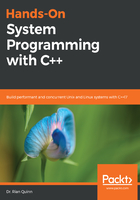
Meltdown and Spectre
The Meltdown and Spectre attacks are a modern examples of just how complicated system calls are to implement. To support the fast execution of system calls, the kernel's memory is mapped into each application using a memory layout technical called the 3:1 split, which refers to the three-to-one ratio of application memory to kernel memory.
To prevent an application from reading/writing kernel memory, which may or may not contain highly-sensitive information such as encryption keys and passwords, modern CPU architectures provide a mechanism to lock down the kernel portion of this memory, such that only the kernel is capable of seeing it all. The application is only able to see its deprivileged portion of that memory.
To improve the performance of these modern CPUs, most architectures, including Intel, AMD, and ARM, incorporate a technology called speculative execution. For example, look at the following code:
if (x) {
do_y();
}
do_z();
The CPU doesn't know whether x is true or false until it executes this instruction. If the CPU assumes that x is true, it can enhance performance by saving some CPU cycles. If x does, in fact, end up being true, the CPU saves cycles, whereas if x is actually false, the penalty is usually worth the risk, especially if the CPU can make an educated guess as to the likelihood of x being true instead of false (for example, if the CPU executed this statement in the past and x was true).
This type of optimization is called speculative execution. The CPU is executing code, even though it's possible the code may later turn out to be invalid and need to be undone.
Speculative execution attacks such as Meltdown and Spectre exploit this process to bypass the memory protections that protect the system call interface between an application and its kernel. This is done by convincing the CPU to speculatively execute an instruction that would typically cause a security violation (for example, attempting to read a password from kernel memory).
If the CPU speculatively executes this type of instruction, there will be a gap between the CPU loading the password into the CPU's cache, and the CPU figuring out that a security violation has occurred. If the CPU is interrupted during this gap (using what is called a transient instruction), the password will be left in the CPU's cache, even though the instruction never actually completed its execution.
To recover the password from the cache, attackers leverage additional attacks on the CPU called side-channel attacks, which are specifically designed to read the contents of a CPU's cache without performing a direct memory operation.
The end result is that an attacker is capable of setting up an elaborate set of conditions that will eventually allow them to recover sensitive information stored in the kernel, using nothing more than an unprivileged application (which could be a website you happened to click on while looking for cat videos).
If this seems complicated, that's because it is. These types of attacks are extremely sophisticated. The goal of these examples is to provide a brief overview of why system calls are not without their issues. Depending on the CPU and operating system you're executing on, you might have to take special care when handling sensitive information while system programming.